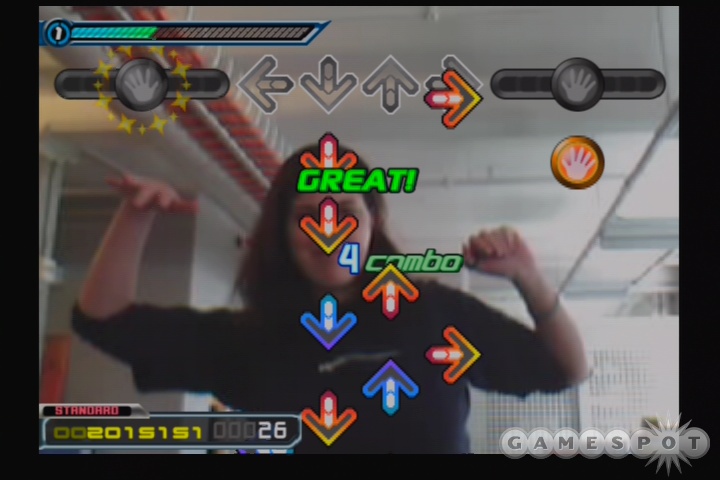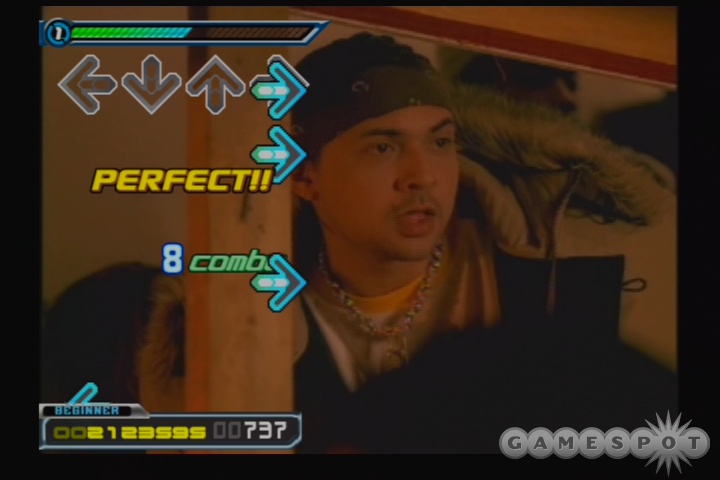Dance Dance Revolution Extreme 2 is the ninth North American console version of the popular step-rhythm arcade game Dance Dance Revolution. Although the series has made a number of tweaks from one version to the next--from those as minor as updating the presentation of the menus, to those as major as adding brand-new modes--the DDR games are all pretty much cut from the same cloth, for better or for worse. Dance Dance Revolution Extreme 2 is not tremendously different from the previous game on the PlayStation 2, DDR Extreme, but dedicated DDR fans will likely appreciate the batch of new songs and the challenge of unlocking them all again. Less-serious fans might not have a reason to buy more than one version of DDR, except for the song list, which has a few gems in this iteration, though it's not particularly outstanding. The online mode is the most significant addition to this game. However, you might want to wait the inevitable one or two more entries in the series before the game is compelling enough to be worth buying. Dance Dance Revolution Extreme 2 is a good addition to the series, but it's not different enough to appeal to anyone other than the biggest of DDR fans.

Dance Dance Revolution is an arcade game that uses a floor controller consisting of four arrow buttons that players must step on in sequence with arrows scrolling on the screen. Ever since the PlayStation, Konami has been translating the arcade experience to home systems, adapting the gameplay and incorporating new modes. Although there's a wide variety of difficulty with any DDR game, their greatest collective achievement has been to cultivate a following of players that has perfected each of the games' songs at every difficulty. It's for these players that subsequent DDR games continue to be released, and it's because of them that the changes to each version are never very dramatic.
Despite the new additions here and there, each DDR game follows the same basic formula. There's a competitive mode through which you can unlock additional songs. In DDR Extreme 2, this mode is called dance master mode, which is where you'll spend the bulk of your time--at least initially. There's also free play mode, which lets you play any of the songs you've unlocked at your own whim. Thankfully, you can now play as many songs as you like without interruption. In previous games, the system would reset after three songs and force you to navigate through the menus again to continue playing. Workout mode counts your calories and keeps a running tally of your DDR playing on your memory card. Unfortunately, this would be much better as an option to turn on throughout any of the modes, since you can't do any unlocking and you can't progress in workout mode. The lesson mode is there for total beginners, and it's very useful in that it shows you which feet to use for certain step patterns. Training is also helpful, because it lets you break up any song at any difficulty, and it lets you simply play whichever bars of music you want to hear over and over again until you've perfected the steps for that sequence. You can also turn on a hand clap or metronome to help you keep time. Finally, there's advanced mode, which is for the DDR elite to show off their skills. Advanced mode incorporates the nonstop mode from previous DDR games, as well as the "Oni" style of DDR play under the name "challenge."
No matter which mode you're in, you'll be able to select from a few different types of gameplay. Single-player is for one person on one mat, versus is for two people on two mats, and double is for one person on two mats. DDR Extreme, the previous game in the franchise, was the first to include an additional style (called hands and feet) for the free play portions of the game, along with support from the EyeToy (Sony's peripheral camera) so you can add hand gestures to the rhythm-motion mix. Although this seriously upped the ante from previous games in the series at the time, the hands and feet mode has made no major changes since DDR Extreme.
The only major change to gameplay is the addition of the online mode, which lets you compete against other PS2 broadband players for rankings on scoreboards and in head-to-head competitions at a number of different skill levels. Skill level is determined based on how many hours you've put into your memory card, but predictably, there are plenty of DDR experts who are just new to this version of the game but have maxed out the rankings for the beginner levels. Alternatively, you can play head-to-head and suffer the same problems, if only you could find someone to play head-to-head against. The challenge of this mode is finding someone to play against, rather than actually playing the game. Otherwise, you can get your competition kicks the old way: by practicing at home and then heading out to your local arcade to find the inevitable DDR crowd there.
Since this game relies so heavily on music, the worth of the game depends mainly on the soundtrack. In a turn from most DDR Games, Extreme 2 has only 24 songs open at the start, so you must unlock 50 more by playing the game's extensive dance master mode. Unfortunately, those familiar with the franchise might get a little bored having to play so many easy songs simply to unlock the more difficult ones, but it's a nice progression for new players. Dance master mode also facilitates unlocking additional outfits for your avatars, as well as new courses and information pertaining to, among other things, the locations of hidden arrows that will boost your score even more.

Unlike older DDR games, the avatars seem to play a little more dominant role in the gameplay. You're forced to choose one each time you begin a new mode, and even though you're able to turn off the avatars completely, perfectionists will want to use them to unlock everything in the game. What this means for gameplay is that on top of the swirling backdrops--but next to the moving arrows--will be a little dancing character that does nothing more than decorate the screen. The avatars don't add much and seem a little distracting, but since there's not much else to the graphics, some people might find them better than nothing. That's not to say the game's appearance is lacking, but since it is a rhythm game, not much can be expected from it. A few of the licensed songs will have the corresponding music video, which is actually quite nice.
There are quite a number of new songs in Extreme 2, but many of the licensed ones are covers of older pop songs by such outdated artists as Britney Spears, first-album Christina Aguilera, and Ricky Martin. There are a few more-recent hits, such as "Crazy in Love" by Beyonce Knowles and Sean Paul's "Get Busy," but most of the licensed hits (even when they're good) are too old, like "Block Rockin' Beats" from the Chemical Brothers. The oft-missed DDR classic "Boom Boom Dollar" finally makes a reappearance, and you'll be able to hear a number of songs (predictably) from DDR mixer Naoki and the charismatic Captain Jack. Some of the better licensed songs in the game are from the Sneaker Pimps, who are surprisingly danceable, and a trance classic by Delirium featuring Sarah McLachlan. There is also an interesting song called Polovtsian Dances and Chorus from Konami's new action game OZ, which is currently only slated for Japanese release. As you dance, you'll be treated to sequences from the game, which gives you a sort of "meta" feeling as you're dancing in a game to full-motion videos from another.
There's not much surprising about this DDR update. The most DDR-fanatic players will appreciate all the new challenges this game provides, if only because they provide some modicum of change. However, the less enthused will find these changes much less noticeable, so they might want to wait another version or two before getting the game.